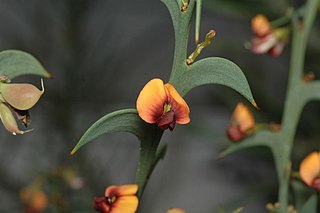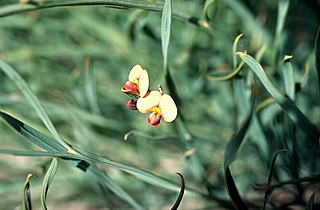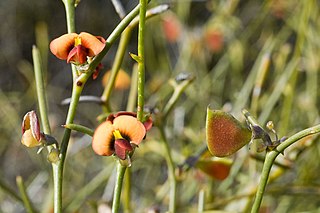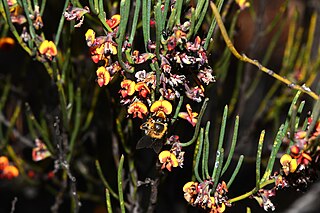
Daviesia horrida, commonly known as prickly bitter-pea, is a species of flowering plant in the family Fabaceae and is endemic to the south-west of Western Australia. It is a spreading shrub with rigid, spiny branchlets, narrowly elliptic phyllodes and orange and dark red flowers.

Daviesia hakeoides is a species of flowering plant in the family Fabaceae and is endemic to the south-west of Western Australia. It is a shrub with many tangled stems, scattered sharply-pointed phyllodes and yellow or orange and dark red flowers.
Daviesia pseudaphylla, commonly known as Stirling Range daviesia, is a species of flowering plant in the family Fabaceae and is endemic to the Stirling Range in the south-west of Western Australia. It is an open, spreading, glabrous shrub with low-lying stems, scattered, cylindrical phyllodes indistinguishable from branchlets, and orange-yellow and dark reddish flowers.

Daviesia aphylla is a species of flowering plant in the family Fabaceae and is endemic to the south-west of Western Australia. It is an erect, bushy shrub with glabrous foliage, up to six sharply-pointed phyllodes on each branchlet, and orange-red and yellow flowers.

Daviesia dilatata is a species of flowering plant in the family Fabaceae and is endemic to the south-west of Western Australia. It is an erect, open, glabrous shrub with scattered, often sickle-shaped phyllodes, and orange, red, yellow and dark crimson flowers.

Daviesia emarginata is a species of flowering plant in the family Fabaceae and is endemic to the south-west of Western Australia. It is an erect, mostly glabrous shrub with scattered egg-shaped phyllodes with the narrower end towards the base and with a notch at the tip, and yellow and pink flowers.
Daviesia eremaea is a species of flowering plant in the family Fabaceae and is endemic to central Australia. It is an erect, glabrous, multi-stemmed shrub with needle-like, more or less sharply-pointed phyllodes, and yellow and red flowers.

Daviesia flexuosa is a species of flowering plant in the family Fabaceae and is endemic to the south-west coast of Western Australia. It is a glabrous, spreading shrub with zig-zagged branchlets, scattered, sharply-pointed, narrowly triangular phyllodes and yellow and red flowers.

Daviesia glossosema, commonly known as maroon-flowered daviesia, is a species of flowering plant in the family Fabaceae and is endemic to a restricted area of south-western Western Australia. It is an erect shrub with tangled, spreading branches, cylindrical, sharply-pointed phyllodes, and unusually-shaped maroon flowers.

Daviesia implexa is a species of flowering plant in the family Fabaceae and is endemic to the south-west of Western Australia. It is a mound-shaped shrub with many tangled stems, scattered linear phyllodes and yellow or apricot-coloured, reddish-brown and yellowish-green flowers.

Daviesia incrassata is a species of flowering plant in the family Fabaceae and is endemic to the south-west of Western Australia. It is an erect, mounded to spreading shrub with more or less zigzag branchlets, scattered needle-shaped phyllodes and orange, deep red and pink flowers.

Daviesia intricata is a species of flowering plant in the family Fabaceae and is endemic to the south-west of Western Australia. It is a glabrous shrub with densely tangled branches, sharply-pointed, needle-shaped or flattened phyllodes and apricot-yellow and dark red flowers.

Daviesia major is a species of flowering plant in the family Fabaceae and is endemic to the south-west of Western Australia. It is an erect, many-stemmed shrub with scattered, erect, sharply-pointed, cylindrical phyllodes and orange and red flowers.

Daviesia mesophylla is a species of flowering plant in the family Fabaceae and is endemic to the south-west of Western Australia. It is a low-lying, glabrous shrub with sharply-pointed, linear or narrowly egg-shaped phyllodes with the narrower end towards the base, and yellow to orange, red and cream-coloured flowers.

Daviesia nematophylla is a species of flowering plant in the family Fabaceae and is endemic to the south-west of Western Australia. It is a dense, erect shrub with glabrous foliage, erect, usually needle-shaped phyllodes, and yellow, orange and dark red flowers.

Daviesia oxyclada is a species of flowering plant in the family Fabaceae and is endemic to the south-west of Western Australia. It is a densely-branched, glabrous shrub with spiny stems, vertically compressed, triangular phyllodes with the narrower end towards the base, and yellow or orange flowers with red markings.

Daviesia purpurascens, commonly known as purple-leaved daviesia, is a species of flowering plant in the family Fabaceae and is endemic to the south-west of Western Australia. It is a glabrous shrub with many branchlets, scattered, erect, cylindrical, sharply pointed phyllodes and yellow and maroon flowers.

Daviesia quadrilatera, commonly known as buggery bush, is a species of flowering plant in the family Fabaceae and is endemic to the south-west of Western Australia. It is a robust, erect, glabrous shrub with angular branchlets, vertically flattened, sharply-pointed quadrilateral or triangular phyllodes with a sharp point on the end, and yellow to orange and red flowers.

Daviesia ramosissima is a species of flowering plant in the family Fabaceae and is endemic to the south-west of Western Australia. It is a shrub with many branchlets, scattered, needle-like, sharply pointed phyllodes and orange-yellow and red flowers.

Daviesia rhizomata is a species of flowering plant in the family Fabaceae and is endemic to the south-west of Western Australia. It is a low, rhizome-forming shrub with tangled branchlets, scattered, needle-like, sharply pointed phyllodes, and yellow and red flowers.


















